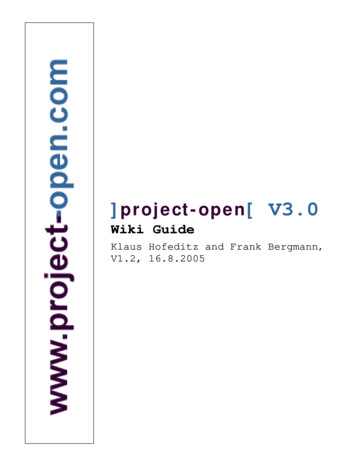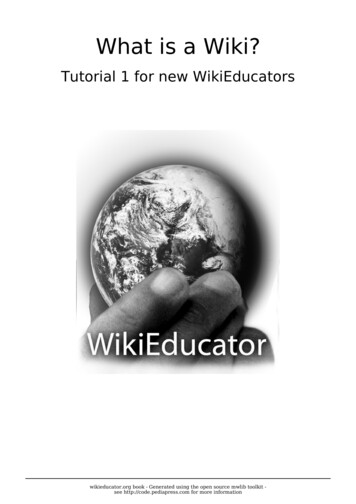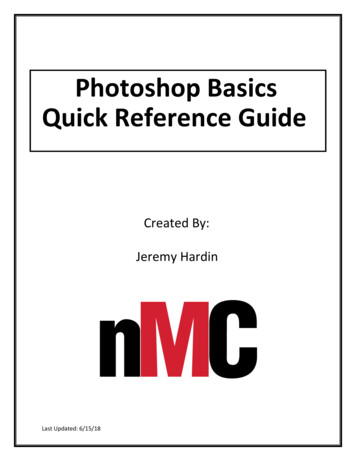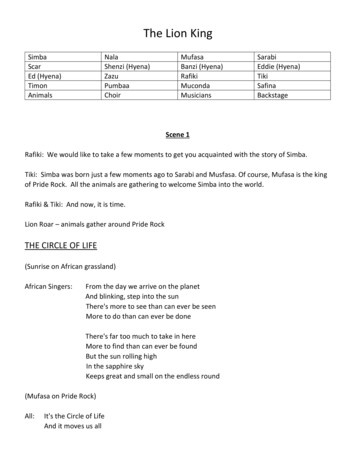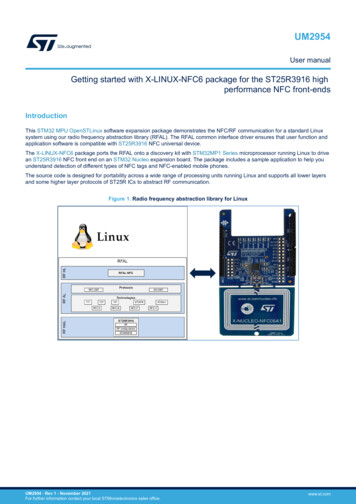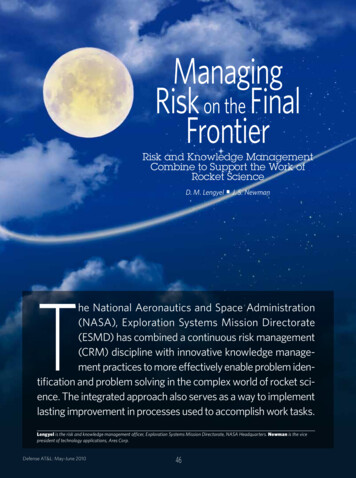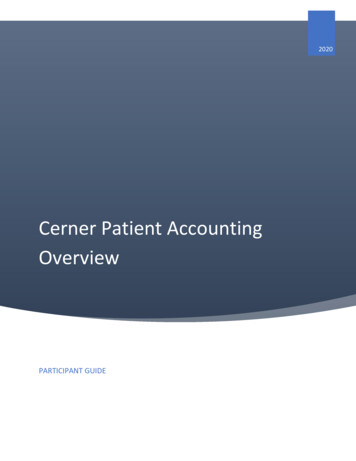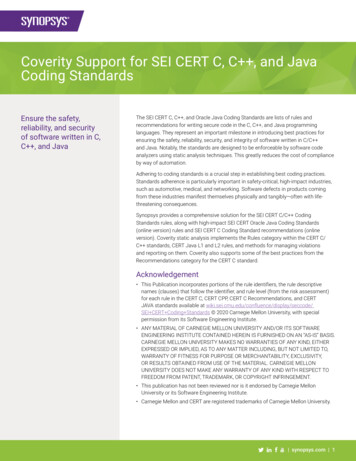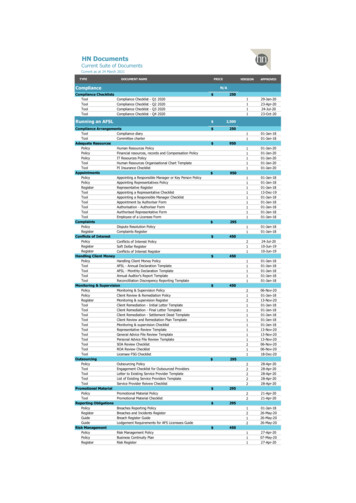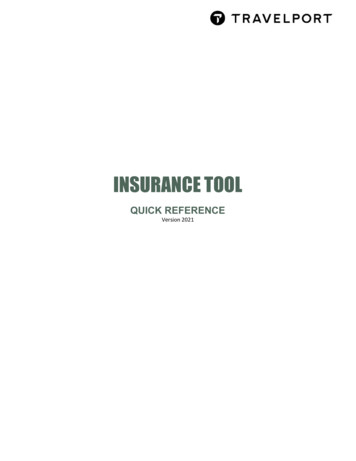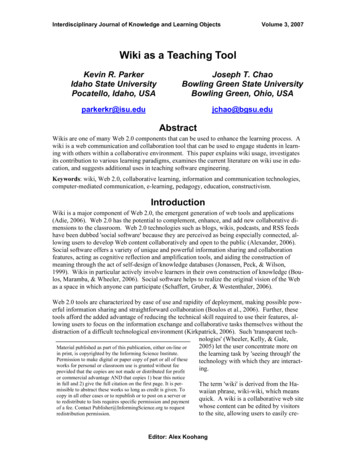
Transcription
Interdisciplinary Journal of Knowledge and Learning ObjectsVolume 3, 2007Wiki as a Teaching ToolKevin R. ParkerIdaho State UniversityPocatello, Idaho, USAJoseph T. ChaoBowling Green State UniversityBowling Green, Ohio, USAparkerkr@isu.edujchao@bgsu.eduAbstractWikis are one of many Web 2.0 components that can be used to enhance the learning process. Awiki is a web communication and collaboration tool that can be used to engage students in learning with others within a collaborative environment. This paper explains wiki usage, investigatesits contribution to various learning paradigms, examines the current literature on wiki use in education, and suggests additional uses in teaching software engineering.Keywords: wiki, Web 2.0, collaborative learning, information and communication technologies,computer-mediated communication, e-learning, pedagogy, education, constructivism.IntroductionWiki is a major component of Web 2.0, the emergent generation of web tools and applications(Adie, 2006). Web 2.0 has the potential to complement, enhance, and add new collaborative dimensions to the classroom. Web 2.0 technologies such as blogs, wikis, podcasts, and RSS feedshave been dubbed 'social software' because they are perceived as being especially connected, allowing users to develop Web content collaboratively and open to the public (Alexander, 2006).Social software offers a variety of unique and powerful information sharing and collaborationfeatures, acting as cognitive reflection and amplification tools, and aiding the construction ofmeaning through the act of self-design of knowledge databases (Jonassen, Peck, & Wilson,1999). Wikis in particular actively involve learners in their own construction of knowledge (Boulos, Maramba, & Wheeler, 2006). Social software helps to realize the original vision of the Webas a space in which anyone can participate (Schaffert, Gruber, & Westenthaler, 2006).Web 2.0 tools are characterized by ease of use and rapidity of deployment, making possible powerful information sharing and straightforward collaboration (Boulos et al., 2006). Further, thesetools afford the added advantage of reducing the technical skill required to use their features, allowing users to focus on the information exchange and collaborative tasks themselves without thedistraction of a difficult technological environment (Kirkpatrick, 2006). Such 'transparent technologies' (Wheeler, Kelly, & Gale,2005) let the user concentrate more onMaterial published as part of this publication, either on-line orin print, is copyrighted by the Informing Science Institute.the learning task by 'seeing through' thePermission to make digital or paper copy of part or all of thesetechnology with which they are interactworks for personal or classroom use is granted without feeing.provided that the copies are not made or distributed for profitor commercial advantage AND that copies 1) bear this noticein full and 2) give the full citation on the first page. It is permissible to abstract these works so long as credit is given. Tocopy in all other cases or to republish or to post on a server orto redistribute to lists requires specific permission and paymentof a fee. Contact Publisher@InformingScience.org to requestredistribution permission.The term 'wiki' is derived from the Hawaiian phrase, wiki-wiki, which meansquick. A wiki is a collaborative web sitewhose content can be edited by visitorsto the site, allowing users to easily cre-Editor: Alex Koohang
Wiki as a Teaching Toolate and edit web pages collaboratively (Chao, 2007). In essence, a wiki is a simplification of theprocess of creating HTML web pages in combination with a system that records each individualchange that occurs over time, so that at any time a page can be forced to revert to any of its previous states. A wiki may also provide tools that allow the user community to monitor the constantly changing state of the wiki and discuss the issues that emerge. Some wikis restrict accessto a group of members, allowing only members to edit page content although everyone may viewit. Others allow completely unrestricted access, allowing anyone to both edit and view content(Olson, 2006). Wikis can be used as a source of information and knowledge, as well as a tool forcollaborative authoring. Wikis allow visitors to engage in dialog and share information amongparticipants in group projects, or to engage in learning with each other by using wikis as a collaborative environment in which to construct their knowledge (Boulos et al., 2006).This paper will focus on the use of wikis in the classroom, beginning with a brief look at learningapproaches that can be furthered through wikis, followed by a review of the current state of wikiuse in education. It will then consider additional uses of wikis in education, and conclude with adiscussion of appropriate uses of wikis rather than blogs.Approaches to LearningMany of the papers that deal with wikis in education indicate how a wiki supports a particularapproach to learning. The most commonly listed learning paradigms are the cooperative/collaborative learning paradigm and the constructivist paradigm, although others are referenced.Cooperative/Collaborative ParadigmAs noted, wikis are characterized by a variety of unique and powerful information sharing andcollaboration features. In cooperative learning, students work in heterogeneous groups to supportthe learning of their individual members. Cooperative learning leads to positive interdependenceof group members, individual accountability, face-to-face interaction, and appropriate use of collaborative skills (Schaffert, Bischof, et al., 2006). Cooperative teams achieve higher levels ofthought and retain information longer than students who do their work individually (Johnson andJohnson, 1986). The collaborative features of wikis make them particularly well suited for cooperative learning environments (Schaffert, Bischof, et al., 2006).Wikis can be used to facilitate computer-supported collaborative learning, i.e., the developmentof collaboration by means of technology to augment education and research (Augar, Raitman, &Zhou, 2004). This enhances peer interaction and group work, and facilitates sharing and distributing knowledge and expertise among a community of learners (Lipponen, 2002). Wikis enhanceasynchronous communication and cooperative learning among students, and promote cooperationrather than competition (De Pedro et al., 2006).Collaborative learning becomes even more powerful when it takes place in the context of a community of practice. A community of practice consists of people engaged in collective learning ina shared domain. Thus, learning becomes a collaborative process of a group. Wikis can serve asa knowledge platform for a community of practice where members of the community can sharetheir knowledge with the group, put up interesting pieces of information, work together, discussissues, etc. (Schaffert, Bischof, et al., 2006). Wikis are characterized by some of the elementsfundamental to a successful community of practice, including a virtual presence, a variety of interactions, easy participation, valuable content, connections to a broader subject field, personaland community identity and interaction, democratic participation, and evolution over time(Schwartz, Clark, Cossarin, & Rudolph, 2004).58
Parker & ChaoConstructivist ParadigmConstructivism sees knowledge as well as meaning as constructed rather than given. Constructivism itself does not suggest a particular pedagogy, but rather describes how learning happens.Miers (2004) provides a fine summary of constructivism:[C]onstructivist learning should engage students in meaningful learning and . the criticalfeatures are that the learning should be. Active and manipulative, engaging students in interactions and explorations withlearning materials and provid[ing] opportunities for them to observe the results oftheir manipulationsConstructive and reflective, enabling students to integrate new ideas with priorknowledge to make meaning and enable learning through reflectionIntentional, providing opportunities for students to articulate their learning goals andmonitor their progress in achieving themAuthentic, challenging and real-world (or simulated), facilitating better understanding and transfer of learning to new situationsCooperative, collaborative, and conversational, providing students with opportunitiesto interact with each other to clarify and share ideas, to seek assistance, to negotiateproblems, and discuss solutions. (p. 4)In recent years, those involved in online learning have had a growing awareness of the benefits ofconstructivist online learning environments (Seitzinger, 2006). Hence, the recent interest in wikisin education. Constructivism is approached from a variety of perspectives in wiki research, including reflective activity and communal or social constructivism.Reflective learning, one of the critical features of constructivism, refers to structured approachesthat enable students to reflect upon their learning and to understand their own learning processes.Wikis are playing an increasing role in students’ reflective learning, and enrich students’ experience “beyond the mere contingent and often ephemeral details of each project, overlayering thisexperience with a more general and overarching, personally-constructed viewpoint on designprocesses, on how we experience and create the designed world in which each person lives —and a conceptual framework that will enable them to quickly develop their understanding further”(Chen et al., 2005).Wikis allow learners to participate in collaboratively building resources. An essential part of reflective learning is that learners should be encouraged to reflect on their knowledge and make itexplicit. Wikis allow this reflection to be done collaboratively, moving closer to a fully socialconstructivist mode of learning. Because of their very low technological barriers yet very richand flexible functionality, wikis afford the opportunity to offer collaborative, constructive learning more extensively in our educational environments (McMullin, 2005).Social constructivists believe that we learn by social and communal activities. Meaning is shapedand knowledge constructed through discussion with peers and teachers, and through reflection(Higgs and McCarthy, 2005). The collaborative nature of wikis means that they enact knowledgebuilding with and for others, with the focus being on the community rather than on the individuallearner. Wikis are one of the success stories in the world of social constructivism since they canbe rapidly deployed and students can be very quickly operational (Notari, 2003).Other ApproachesThere are additional approaches to learning that are addressed in wiki literature. Yukawa (2005)examines the use of wikis in narrative analysis, which uses both text and online talk to construct a59
Wiki as a Teaching Toolholistic view of the learning experience involving cognition, affect, and interaction. Schaffert,Bischof, et al. (2006) discuss many learning approaches, including cognitive apprenticeship,which is based on the knowledge and skill transfer in the traditional master-apprentice education.The collaborative aspect of wikis allows teachers and students to work closely together on a topic,e.g., writing a text or article, collecting information on a topic, etc., regardless of the whereaboutsof students and teachers. In a broad sense, a wiki can be considered a learning object if it containsan educational purpose (Nash, 2005).Current State of Wikis in EducationAlthough the wiki was introduced more than ten years ago, its use is relatively new in academia(Chao, 2007; Evans, 2006; Schaffert, Bischof, et al., 2006). Higher education has only recentlybegun to explore the potential educational value of wikis as a means to promote deeper learningand integration of learning experiences from both inside the classroom and out (Chen et al.,2005). Despite their potential impact on business, the wiki phenomenon, by and large, has not yetmade it to the classroom, either as a research topic or as a teaching method (Evans, 2006). However, the popularity of wikis has begun to attract the attention of educators, who expect that wikiswill facilitate not only communication but also the collaborative finding, shaping, and sharing ofknowledge, all of which are essential properties in an educational context (Reinhold, 2006). As aconsequence, papers related to wiki use in education have finally begun to appear in recent years.A literature search reveals the current state of the wiki education. There are a variety of applications, primarily in writing assignments, group projects, and online/distance education, althoughinnovative uses in other areas can be found as well.Lists of UsesThere are several papers that, among their discussion of wikis, present a list of uses for wikis inthe classroom, along with a discussion of each in most cases. Mader’s site (2006b) focuses solelyon wikis in education, citing uses such as simple webpage creation, project development withpeer review, group authoring, tracking group projects, data collection, and class/instructor reviews. His online text (Mader, 2006a) contains writings by several authors discussing such topicsas integrating a wiki in instruction, collaborative writing projects, group wiki projects, usingwikis within course management systems, constructing science knowledge, and wiki-based collaboration and academic publishing. Fountain (2005) presents a survey of wiki use in education,and suggests several additional uses of wikis. Co-creating and co-monitoring projects are discussed, as is collaborative concept elaboration.Duffy and Bruns (2006) list several possible educational uses of wikis: 60Students can use a wiki to develop research projects, with the wiki serving as ongoingdocumentation of their work.Students can add summaries of their thoughts from the prescribed readings, building acollaborative annotated bibliography on a wiki.A wiki can be used for publishing course resources like syllabi and handouts, and students can edit and comment on these directly for all to see.Teachers can use wikis as a knowledge base, enabling them to share reflections andthoughts regarding teaching practices, and allowing for versioning and documentation.Wikis can be used to map concepts. They are useful for brainstorming, and editing agiven wiki topic can produce a linked network of resources.A wiki can be used as a presentation tool in place of conventional software, and studentsare able to directly comment on and revise the presentation content.
Parker & Chao Wikis are tools for group authoring. Often group members collaborate on a document byemailing to each member of the group a file that each person edits on their computer, andsome attempt is then made to coordinate the edits so that everyone’s work is equally represented; using a wiki pulls the group members together and enables them to build andedit the document on a single, central wiki page.Guzdial, Rick, and Kehoe (2001) recount how wikis, including their CoWeb, can be used forclassroom activities such as distributing information, collaborative artifact creation, and discussion and review. Naish (2006) describes wiki use in learning as an information resource, a collaboration tool, a tool for building e-learning content, and as icebreakers. The concept of workflow learning in action is thoroughly discussed. Schaffert, Bischof, et al. (2006) suggest the useof wikis in project-based learning, collaborative story writing, and interdisciplinary and intercultural learning.Tonkin (2005) identifies four different forms of educational wikis:1. Single-user wikis allow an individual to collect and edit his or her own thoughts using aWeb-based environment.2. Lab book wikis allow students to keep notes online with the added benefit of allowingthem to be peer reviewed and changed by fellow students.3. Collaborative writing wikis can be used by a team for joint writing.4. Knowledge base wikis provide a knowledge repository for a group.Lamb (2004) points out that some faculty utilize wikis so that design teams can quickly and collaboratively build reference lists and outlines, brainstorm instructional strategies, and capturesuggestions. Bergin (2002) suggests a variety of uses for wikis including student homepages,anonymous feedback, student-created FAQ, ideas related to the course, infrastructure hints, anddiscussions. Schwartz et al. (2004) survey twenty-four universities and report how wikis are being used. They report that most dealt with activities, events, or clubs rather than with curricularissues.Wikipedia's (2006) School and University Projects page suggests uses of wikis in the classroomto provide students with exercises editing and publishing content on Wikipedia.Writing AssignmentsPerhaps the most common pedagogical application of wikis is supporting writing instruction(Lamb, 2004). Using a wiki as a writing tool maximizes the advantages of reflection, reviewing,publication, and of observing cumulative written results as they unfold (Fountain, 2005).Lamb (2004) reports that a wiki called "Why Use Wikis to Teach Writing" lists a number of themedium’s strengths for the teaching of writing skills: wikis stimulate writing ('fun' and 'wiki' are often associated);wikis provide a low-cost but effective communication and collaboration tool (with anemphasis on text rather than software);wikis promote the close reading, revision, and tracking of preliminary work;wikis discourage 'product oriented writing' while facilitating 'writing as a process'; andwikis ease students into writing for a wider audienceBarton (2004) lists some innovative uses for wikis in composition:1. Any class project with a reference or encyclopedic format, such as instructions, usermanuals, glossaries, etc.61
Wiki as a Teaching Tool2. A class or group project with a bibliographic format that requires students to locate websites related to a topic, and then annotate, rank, and organize them.3. A handbook or textbook. For example, students could build a guide to correct punctuation, which could be compiled and evaluated as a class, giving every student a stake inthe project and benefiting each from the authoring process.4. Any project that does not require individual authorship or protected documents.Rick, Guzdial, Carroll, Holloway-Attaway and Walker (2002) studied two sections of an EnglishComposition class, taught by the same instructor. The first section used CoWeb, a wiki-basedtool, to complete various assignments while the comparison section performed the same activities, but worked in a threaded-discussion on-line environment similar to a Usenet newsgroup. Ineach rating category, the CoWeb section outperformed the comparison section, in most cases by alarge statistically significant amount.Forte and Bruckman (2006) discuss the writing-to-learn paradigm, focusing on how to engagestudents in collaborative writing activities. They investigate how to design wiki publishing toolsand curricula to support learning among student authors, and suggest that collaborative publishingon a wiki offers an interesting model for creating authentic classroom writing activities and canbe a powerful tool for constructing knowledge.Byron (2005) discusses the uses of wikis in his distance learning symbolic logic class. Studentswere required to summarize various assigned readings and post them on the wiki, and the rest ofthe class was allowed to edit collaboratively those postings to improve both accuracy and completeness.Hampel, Selke, and Vitt (2005) focus on collaborative writing methods and the requirements oftools used with special consideration of wikis. They then go on to describe the concrete realization of a fusion of semantic-spatial structuring techniques and collaborative writing, consideringthe integration of wiki techniques into virtual knowledge spaces.Schaffert, Bischof, et al. (2006) discuss the concept of collaborative creative writing, in which awiki serves as an interactive writing book, allowing students to collaboratively write an essay orstory. Such collaboration offers numerous opportunities. For example, a story may have morethan one ending, or it could even branch out like a tree based on different twists and conclusions.More artistically inclined students could supplement the story with illustrative figures or images.Bruns and Humphreys (2005) describe how a wiki-based project was incorporated into a newmedia technologies course. Students developed the M/Cyclopedia (Media/Culture), a wiki-basedencyclopedic collection of information on new media concepts and topics, using Wikipedia’sMediaWiki. The wiki system was also used for student interactions, discussions, coordination,and tutorials outside of classes. The editing of each wiki subject was limited to students in theparticular subject to facilitate student assessment. Lund and Smørdal (2006) discuss a similarproject, in which technology is the same and the assignments are based on similar ideas of lettingthe learners co-construct subject entries in an encyclopedia.Scardamalia and Bereiter (1994) speculate that one of the key drivers of collaborative writingmay be dissatisfaction in interplay. If students do not like what they see, such as the approachtaken by others, they may be more inclined to participate in order to propose an alternative approach. De Pedro et al. (2006) discuss one of the drawbacks of writing documents collaboratively. Students must be able to overcome their reluctance to allow others to see their unfinishedworking documents, and must be willing to let others contribute changes.62
Parker & ChaoProject-based LearningSchwartz et al. (2004) point out that project-based learning is fairly common in various fields including music and languages. Projects play a large role in the context of educational environments because the project method is seen as a way to reach education goals. Wikis represent avery effective tool for project planning and documentation (Schaffert, Bischof, et al., 2006).When used for collaborative class projects, wikis allow students to meet virtually at their convenience and work on projects together (Byron, 2005). A geographically dispersed project teamcould use a wiki as a way of keeping in touch, sharing ideas and developing the project. Becauseall comments/ideas are consolidated on one webpage, a wiki creates a clearer picture of team direction than do individual email messages (Naish, 2006).Fountain (2005) suggests several applications of a wiki in project integration work, includingmanaging a long-term design process, problem solving, permitting constructive critique of pedagogical projects, allowing commentaries/critiques on project integration work, and crossclass/course projects. Schaffert. Gruber, et al. (2006) suggest ways in which wikis can be usefulin project knowledge management, including brainstorming and exchange of ideas, coordinationof activities, coordination and records of meetings, and serving as a notepad for common information items. Chen et al. (2005) discuss the benefits of wikis in their design engineering groupproject, including enabling students to gather, organize, and share writing, photos, videos, presentations, and other digital creations.De Pedro et al. (2006) collected a list of advantages and disadvantages of the use of wikis fromthe opinions of the teaching staff who administered projects related to innovation in teaching. Apedagogical challenge common in project-based courses is that students see what they have produced but they do not see what they have learned (Chen et al., 2005). Wikis alleviate this problem.Online/Distance EducationA Sloan Consortium study (2006) shows a sharp increase in the number of students taking onlinecourses, reporting that: Almost 3.2 million students took at least one online course during the fall 2005 term, asignificant increase over the 2.3 million students reported the previous year.The more than 800,000 student increase is more than twice the growth recorded in anyprevious year.Wikis are a useful tool for facilitating online learning groups (Augar et al., 2004). They can beused to support the dissemination of information, to enable the exchange of ideas, and to facilitategroup interaction. Further, wikis can be used to create a set of documents that reflect the sharedknowledge of the learning group (Augar et al., 2004).Both Byron (2005) and Tsinakos (2006) discuss their use of wikis in distance learning classes, theformer in a distance learning symbolic logic class and the latter as an environment for the formation of collaborative student models during distance education sessions. Icaza, Heredia, andBorch (2005) detail the use of a wiki in an online graduate course using a pedagogical approachcalled project oriented immersion learning. Students were immersed in the environment of a fictional online publishing house that hires them to develop e-books, tutorials, and websites online.Seitzinger (2006) provides a thorough discussion of the benefits of constructivist online learningenvironments.Wang and Turner (2004) and Elrufaie and Turner (2005) point out several problems using thetraditional wiki paradigm in the classroom:63
Wiki as a Teaching Tool All content is modifiable by any user. For example, the instructor may want to restrictmodifiability of certain pages, such as a course syllabus or assignments. All content is public. The user may want to keep a newly created page private (not visible to others) until a certain point in its development, but wiki technology does not permitthis. Simultaneous edits are allowed but not successful. In order to allow several users to editthe contents of a given page simultaneously, a page locking mechanism is necessary toprevent overriding each other. The wiki is forever evolving. When a class ends the instructor may wish to freeze thewiki pages into an historical artifact rather than letting it evolve without end, but mostwikis do not provide this feature.The authors extended the basic wiki paradigm to overcome the undesirable features listed above,and to better serve the needs of their online class.Other Applications of WikisZinn (2006), Schaffert, Bischof, et al. (2006), and Schaffert, Griber, et al. (2006) present researchon semantic wikis, i.e., a combination of a wiki and Semantic Web technology. Zinn (2006) developed a semantic wiki to serve as a mathematical resource for learners and researchers, madeup of semantically linked documents, definitions, theorems, lemmas, proofs, exercises, and overfour hundred examples. Schaffert, Bischof, et al. (2006) and Schaffert, Griber, et al. (2006) discuss how semantic wikis can support learners in flexible learning environments.Both Augar et al. (2006) and Naish (2006) mention the use of wikis as an icebreaker tool foronline groupwork. They demonstrate how wiki technology can be used to enhance social interaction among students online as well as for the dissemination of information to the student body, forbuilding information repositories, or for the collaborative production of documents.Evans (2006) reports on a collaborative effort in which students in an XML class collaborate towrite their own wiki textbook, thus learning the material more thoroughly than they would haveusing a traditional resource. O’Neill (2005) discusses the slides2wiki tool, which can be used tocreate a site where students may collaborate to create their own class notes, using the lectureslides as a starting point. This approach can result in high-quality lecture notes and can providean instructor with valuable feedback on what students have understood. Hamer (2006) reports onthe use of a contributing student approach using wikis in which students research topics and sharethe results with other students. Student contributions are peer assessed through wikis, and lectures become class discussions. Student feedback indicates that the approach improved communication skills, research techniques, and teamwork, but some topics were not covered as thoroughly as were others.Both Wang et al. (2005) and Chang and Schallert (2005) investigate the use of wikis in 'Englishas a Second Language' courses. Honegger (2005) describes the dissemination of wikis in theGerman-speaking school community, Switzerland in particular. They found that simplicity,openness, and lack of structure facilitates wiki use in schools, while the lack of wiki servers, lackof instructor IT skills, lack of a WYSIWYG editor, and traditional instructors were the barriers towiki use in schools.Lamb (2004) describes various examples of wiki use outside the classroom. Placement centerscan use wiki pages to store and organize content for job postings and career development. Wikiscan be provided by the university to act as a sounding board so that students can voice opinionsabout university policies.64
Parker & ChaoMore Wiki StudiesGuzdial, Ludovice, Realff, Morley, and Carroll (2002) report that although CoWeb, a wiki-basedtool, has been used successfully in several courses in various disciplines, the tool has been unsuccessful in a variety of math, engineering and computer science courses. Their survey indicatesthat the causes for the lack of success include too much student competition, students too confused to post questions on CoWeb, and faculty opposition to student collaboration.The case study performed by Raitman, Ngo, Augar and Zhou (2005) tests students’ sense of security (identity) when using wikis for online collaboration. Two wikis were set up; one requireduser login and one remained anonymous. The results showed the students preferred a user loginwiki since they felt more secure. The wiki with required user login had significantly higher usage(number of pages, number of edits, number of views, etc.
wiki is a web communication and collaboration tool that can be used to engage students in learn-ing with others within a collaborative environment. This paper explains wiki usage, investigates . the emergent generation of web tools and applications (Adie, 2006). Web 2.0 has the potential to complement, enhance, and add new collaborative di- .
